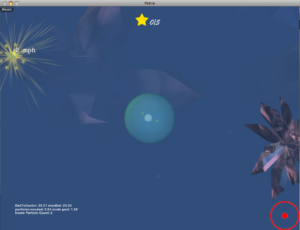[Note: For those of you getting this link because of your “(baby)alexis” notifications, I couldn’t help not including you. :)] Osy (“Osy Osmosis”), a game cooperatively developed by myself and members of a research team at the University of Georgia hit the App Store late last night. Osy’s development has spanned just about two years now, though actual development time was about three months to vertical slice, which was the deployed widely for preliminary testing throughout schools in Georgia. It is this version of the game featured in the documentary piece found on the Osy website. Little happened with the game after that point until April of 2010, when the UGA OVPR provided a VentureLab seed grant for our freshly created company IS3D, LLC. A portion of this money was used to port Osy to iOS and move the game into full production. It paid for bringing in wonderful folks like Ben Throop in to tell us what we’re doing right and wrong.
What makes Osy special, for me, is that it is my stab at thinking about making games… that just happen to contain concepts that educators are interested in teaching to students. I often say very deliberately that Osy is not “edutainment.” Put more academically, the procedural rhetoric of Osy is the story of osmosis. Too often, educational games ignore the procedural rhetoric and only thinly layer educational images/concepts on top of game mechanics that have nothing to do with the message they hope to deliver. In far too many cases it is actually worse, “gamelike” visuals are layered on top of quiz/test systems and it is referred to as a “game.” In part, this is because testing/quizzing is the primary procedural rhetoric (or game mechanic) of schools. I recall one day during the design of Osy where I said something to the effect, “If you put a quiz in my game, I’m done with it.” This is an approach, that I think is conscientious of the kinds of critiques that some are leveling at the Game-ification of Education.
I’ve also been somewhat worried about many people researching games and education becoming too focused on only the importation of off-the-shelf standard game industry games into the classroom. Isn’t that the equivalent of giving up the ghost? Why not create high quality games with education sitting in the back of your head? Clearly, game developers draw on scientific concepts for the systems within games (physics, evolution, …) though it comes secondary to the overall game. Why not have it as an equal on the field of idea-battles that occur during the development of a game? That I want a player to understand/feel/know X where X includes some scientific knowledge becomes part of the design process.
Go Osy go!
